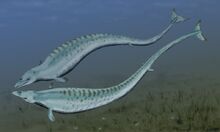
Reconstruction of Basilosaurus
Basilosaurus lived 40 million years ago in the oceans of the world. It was up to 50 tons and 60 feet long. That made it the largest prehistoric whale. Basilosaurus means "king lizard", in greek. The reason it`s named "king lizard" is because when it was first discovered they thought it was a prehistoric marine reptile.
In March 18, 2022, a 36 million year old complete skull of Basilosaurus has been found in Peruvian desert.
Anatomy[]
Measuring 40–65 ft (12–20 m), Basilosaurus cetoides was the largest ocean animal. B. isis is slightly smaller than B. cetoides.
Cranium[]
The dental formula for Basilosaurus isis is 3.1.4.2-3.1.4.3. The upper and lower molars and second to fourth premolars are double rooted and high-crowned.
The head of Basilosaurus did not have room for a melon like modern day toothed whales, and the brain was smaller in comparison as well. It is believed that they therefore did not have the social capabilities of modern whales.

Basilosaurus cetoides
Fahlke et al. 2011 concluded that the skull of Basilosaurus is asymmetrical like in modern toothed whales, and not, as previously assumed, symmetrical like in baleen whales and artiodactyls closely related to cetaceans. In modern toothed whale this asymmetry is associated with high-frequency sound production and echolocation, neither of which is thought to be present in Basilosaurus. This cranial torsion probably evolved in protocetids and basilosaurids together with directional underwater hearing and the sound receiving apparatus in the mandible (the auditory fat pad and the pan bone (thin portion of mandible).
In the Basilosaurus skull, the inner and middle ear are enclosed by a dense tympanic bulla. The synapomorphic cetacean air sinus system is partially present in basilosaurids, including the pterygoid, peribullary, maxillary, and frontal sinuses. The periotic bone, which surrounds the inner ear, is partially isolated. The mandibular canal is large and laterally flanked by a thin bony wall, the pan bone or acoustic fenestra. These features enabled Basilosaurus to hear directionally in water.
The ear of basilosaurids is more derived than those in earlier archaeocetes, such as remingtonocetids and protocetids, in the acoustic isolation provided by the air-filled sinuses inserted between the ear and the skull. The basilosaurid ear did, however, have a large external auditory meatus, strongly reduced in modern cetaceans, but, even-though this was probably functional, it can have been of little use under water.
Spine[]
No complete Basilosaurus skeleton is known, but several attempts have been made to reconstruct the vertebral column from partial skeletons. Kellogg 1936 estimated a total of 58 vertebrae, based on two partial and non-overlapping skeletons of B. cetoides from Alabama. More complete fossils uncovered in Egypt in the 1990s, allowed a more accurate estimation: the vertebral column of B. isis has been reconstructed from three overlapping skeletons to a total of 70 vertebrae with a vertebral formula interpreted as 7 cervical, 18 thoracic, 20 lumbar and sacral, and 25 caudal vertebrae. It can be assumed that the vertebral formula of B. cetoides is the same.
Basilosaurus has an anguilliform (eel-like) body shape because of the elongation of the centra of the thoracic through anterior caudal vertebrae. In life, these vertebrae were filled with marrow, and, because of the enlarged size, this made them buoyant. From this it can be deduced that Basilosaurus swam predominantly in two dimensions at the sea surface, in contrast to the smaller Dorudon which was probably a diving, three-dimensional swimmer. The skeletal anatomy of the tail suggests that a small fluke was probably present, which would have aided only vertical motion. Most reconstructions show a small, speculative dorsal fin similar to a rorqual whales's, but other reconstructions show a dorsal ridge.
Hind limbs[]
A 16 m (52 ft) individual of B. isis had 35 cm (14 in) long hindlimbs with fused tarsals and only three digits. The limited size of the limb and the absence of an articulation with the sacral vertebrae, makes a locomotory function unlikely. Analysis has shown that the reduced limbs could rapidly adduct between only two positions.
Behavior[]
Locomotion[]
It is also believed that Basilosaurus relied on unusual modes of locomotion, relative to other cetaceans; similarly sized thoracic, lumbar, sacral and caudal vertebrae imply that it moved in an anguilliform (eel-like) fashion, but predominantly in the vertical plane. Paleontologist Philip D. Gingerich theorized that Basilosaurus may also have moved in a very odd, horizontal anguilliform fashion to some degree, something completely unknown in modern cetaceans.
The vertebrae appear to have been hollow, and it is likely that they were also fluid-filled. This would imply that Basilosaurus typically functioned in only two dimensions at the ocean surface, compared with the three-dimensional habits of most other cetaceans. Judging from the relatively weak axial musculature and the thick bones in the limbs, Basilosaurus is not believed to have been capable of sustained swimming or deep diving. It is also believed that it was incapable of terrestrial locomotion.
Feeding[]
The cheek teeth of Basilosaurus retain a complex morphology and functional occlusion. Heavy wear on the teeth reveals that food was first chewed then swallowed.
Analyses of the stomach contents of B. cetoides has shown that this species fed exclusively on fishes and sharks, while bite marks on the skulls of juvenile Dorudon have been matched with the dentition of B. isis, suggesting a dietary difference between the two species, similar to that found in different populations of modern killer whales.
